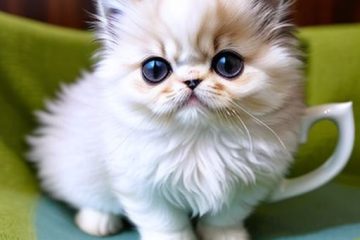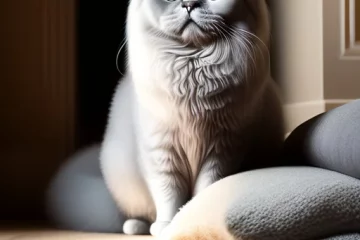Persians are one of the most famous domestic cats. Their specimens come from a mixture of pure Persian and Turkish angora. Both of these cats have no hunting instinct.
Persians are affectionate, aristocratic, calm, and lazy. However, they are the most admired and loved domestic breed of cats.

They are always linked to royalty, luxury, and aristocracy. This feline was brought as his name indicates from Persia (Iran nowadays). But, many specimens that we recognize now are the result of a mixture between the white Turkish angora and the purebred Persian cat.
Afterward, become considered as a highly valued pet that was interbred with more felines giving rise to various races.
If you decide to get a Persian cat, you have to take into account that this pet requires much attention. His beautiful and thick coat needs grooming and care more than other cats.
Many Persian breeders visit cat stylists to keep the cat’s aristocratic appearance and beauty.
This type of cats needs also your time and attention. They will not tolerate your absence for long hours. Therefore, They are highly recommended for people who spend a lot of time at home.
Persians are quiet cats that like to stretch for long hours on the couch rather than chasing butterflies or playing with toys. Thus, they are not advisable for people who have kids because they will love to play more with pets.
Persians are inactive cats and are meant for home life. They have no inclination to hunt or to attack other animals. Some of them may even suffer from agoraphobia.
Then, they are liable to gain weight easily. However, you can contact the veterinarian for advice on how to keep your cat within the normal weight since obesity may cause serious health issues.
It is also a must to adjust your cat’s eating habits and nutrition to suit healthy norms because food is an important factor for your feline’s health and wellbeing.
Persian’s Origin
The Persian cat was brought to Europe by two scholars: Nicholas-Claude Fabri de Pieresc (1580 – 1637) and Pietro Della Valle (1568 – 1652).
The first was a scientist who liked that breed of cat which considered as “wonderful”. The second is an Italian nobleman who was accustomed to travel between Venice and India through Turkey and Persia.
He was astonished When he saw the Persian for the first time. Then, he decided to buy some kittens and send them to Rome in 1921.

Persians Nowadays
Persian cats as known these days appeared in Great Britain in the 19th century when they were mixed with the Turkish angora.
Then, this sweet cat of beautiful appearance and nice fur become famous all over the world. This pet can be found in different body shapes and colors.

The Aristocratic Cat
Persian cats are one of the loved pets throughout history. When first were brought to the western world, people were astonished by their majestic appearance.
Therefore, the aristocratic elite started to breed these cats which makes them enjoy the luxury life of castles and palaces. Queen Victoria was affectionate about Persian cats and had various ones.

A Cat with No Hunting Instinct
While cats like to chase and catch butterflies, birds, lizards, Persians show no hunting interest whatsoever. You could almost imagine an insect moving next to this cute feline without making any response or reaction at all.
They are so lazy. So, they can lay on the same bed all day long. After getting up for about two or three hours, they may go back to sleep again. They prefer to sleep by the feet of their parents.
They are royal and decorative rather than active and energetic cats.

They Have Large Bodies
The Persian cats’ appearance is misleading with their thick coat. They may look bigger than what they really are. They are certainly not as big as a Maine Coon but they are larger than an average domestic cat.
Persians seem very big when their fur is so long.
A healthy female Persian cat weighs between 8-10 lbs(3.6kg-4.5kg).
A healthy adult male Persian cat weighs between 10-13 lbs(4.5kg-6kg).
According to Purina, the Persian cat’s breed size is: Medium to large, with males weighing 9 to 14 pounds and females weighing 7 to 11 pounds.

Sweet Personality
Persians are quiet, gentle that love a calm environment and humans who are kind to them. They are lazy cats so they won’t damage your properties or scale the heights of your bookcase.
Children are welcomed by Persians if they pet them with love and care rather than dragging them around or dressing them up.
These cats have a special way of greeting, they use a quiet meow to do so. But mostly, they will rely on their eyes to communicate with you. Their human’s daily presence will make them so happy.
They will love you forever and make your life full of tenderness, warmth, and happiness.

Highly Appreciated Breed of Cats
Persian cats are appreciated and loved by people all over the world. Their flat brachycephalic faces make them good-looking felines.
They have also a very long, thick, and shiny coat with nice texture which makes the Persian’s look very charming. However, this pet requires daily grooming and care to preserve his/her beauty and elegance.
Additionally, People value these cats because they are well-behaved, sweet-tempered, and affectionate. They can be your best friends ever.
Once you decide to get one into your home, you should be proud that you pet this luxurious, royal, and worthy cat. With these breed of cats, you will feel unlimited love, happiness, and value in your life.

Health Problems
Although Persians are so expensive cats, they are exposed to many health issues. The most common conditions diagnosed in Persians are haircoat disorders, dental disease, overgrown nails, and eye discharge.
A lot of these diseases are related to the cat’s long coat and flat face which are the main characteristics of this feline.
These health problems constitute primary welfare challenges for this cat that should be taken into account by breeders and expected owners. However, providing your cat with healthy food and a balanced diet is a key factor in keeping your lovely pet robust and flourishing.
Additionally, regular visits to the veterinarian are also crucial to prevent risky illnesses and to guarantee the cat’s safety and health.



